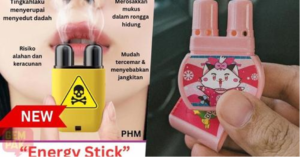 Concerns about the “energy stick” first emerged in October 2023 when it was observed that a significant number of children in China seemed to be excessively using these products. The issue gained national attention almost instantly after a video surfaced, showing a young boy buying the sticks and claiming to be “addicted” to them. This incident sparked widespread debate and raised several important questions: Was the boy truly addicted, or was he simply using the term “addiction” as part of the popular slang in his community? If his claim of addiction was genuine, what ingredients are found in these “energy sticks”? Specifically, is there any component, even in minimal amounts, that could potentially be addictive?
Concerns about the “energy stick” first emerged in October 2023 when it was observed that a significant number of children in China seemed to be excessively using these products. The issue gained national attention almost instantly after a video surfaced, showing a young boy buying the sticks and claiming to be “addicted” to them. This incident sparked widespread debate and raised several important questions: Was the boy truly addicted, or was he simply using the term “addiction” as part of the popular slang in his community? If his claim of addiction was genuine, what ingredients are found in these “energy sticks”? Specifically, is there any component, even in minimal amounts, that could potentially be addictive?
The application of menthol, camphor, and eucalyptus oil in the field of ear, nose, and throat medicine dates back approximately a century and a half. French practitioners introduced these substances to Europe for the first time in 1879, and German medical experts started looking into them in 1884. Initially, they were celebrated as a universal remedy for various nose and throat conditions and were extensively used in formulations with ether and alcohol, with concentrations reaching as high as 50 percent.
Historically, nasal inhalers have been used as a traditional remedy to ease nasal congestion. They typically contain non-addictive substances such as camphor, menthol, and eucalyptus oils. When used, the inhaled vapours from camphor and menthol create a sensation of increased airflow and a feeling of relief from stuffiness. The stimulation of the nasal “cold air” nerve endings, which serve as sensors within our nostrils, is what causes this sensation of airflow, even though the amount of mucous is not reduced.
In the 1950s, nasal decongestants that contained camphor, menthol, and eucalyptus oils were misused as they contained amphetamine, which could lead to addiction. Although the amount is small, people have found ways to extract the drugs from these inhalers, making it a high risk for misuse. Amphetamine is a stimulant known to increase alertness, concentration, and energy, and in some cases, it can induce feelings of euphoria. But since 2016, all forms of amphetamines have been totally removed.
In today’s global market, it is not surprising that “energy sticks” inhalation devices have reached our shores and quickly become a trend among our schoolchildren and teenagers. It was claimed that the content of these devices is harmless over-the-counter items such as camphor, menthol, and eucalyptus oil. If this claim holds true, then we could alleviate our concerns regarding the direct health impacts of the substances inhaled.
We cannot, however, confirm the safety status of the ingredients in the “energy sticks” if the NPRA or the national pharmaceutical regulatory body has not examined them. Plus, it seems that some of the sticks are artificially flavoured, and we need to be sure that they are safe for inhalation.
 There are many unknowns in the chemical concoction that is contained within the stick. We should learn the lessons from the outbreak of EVALI in 2019, of which vitamin E acetate, a thickener used in vape juice, was the prime suspect that caused the damage to the lungs. Although vitamin E acetate is the main suspect, the other harmful compounds that may have been created through the reaction of various ingredients within the device when heated cannot be ruled out. Vitamin E acetate does not harm if ingested, but when it is heated, the vapour reaches areas in the lungs, causing damage.
There are many unknowns in the chemical concoction that is contained within the stick. We should learn the lessons from the outbreak of EVALI in 2019, of which vitamin E acetate, a thickener used in vape juice, was the prime suspect that caused the damage to the lungs. Although vitamin E acetate is the main suspect, the other harmful compounds that may have been created through the reaction of various ingredients within the device when heated cannot be ruled out. Vitamin E acetate does not harm if ingested, but when it is heated, the vapour reaches areas in the lungs, causing damage.
Usually there is no problem inhaling a mixture of camphor, menthol, or eucalyptus oils, but excessive inhalation, such as in this case, may pose risks to children, including irritation to the nose and throat, coughing and wheezing, seizures, confusion, and delirium. However, ingestion of these mixtures in large amounts, although unlikely with the inhalation device, can lead to intoxication of the nervous system and cause death too.

What is more of a concern is the manner in which these energy sticks are marketed. First of all, these energy stick devices closely resemble the vaping device in its mini form. Gradually, the habit of carrying these devices everywhere—holding them in hand, tucking them into school bags, stationery cases, or keeping them in bedrooms—might inadvertently serve as a subtle form of conditioning. This practice could subtly influence children to view the possession and use of such devices as a norm or a status symbol, reinforcing the idea that having a device is synonymous with being trendy or socially accepted.
The energy stick, with its vapor-esque packaging, exudes a modern, contemporary lifestyle that is too appealing to ignore. Its catchy tagline—snort first before going to school—is obviously targeting schoolchildren as its main consumers. The products’ allure is further enhanced by the introduction of various enticing flavours, like watermelon, peach, and mint, coupled with a cheap price point, making them attractive to children and teenagers. One wonders: who is orchestrating this marketing scheme? Why is there a need to promote such products to a young and impressionable demographic?
It’s wise to approach trends with caution and critical thinking. This situation serves as a prime example. Why expose yourself to potential risks by introducing chemicals into your body unnecessarily? Parents should stay informed about the latest trends and offer guidance when something doesn’t seem right. Trusting your instincts is often a good course of action, as they are usually accurate.
This article is written by Dr Helmy Hazmi. He is a community medicine specialist with a specialization in Epidemiology and Biostatistics.
https://www.globaltimes.cn/page/202310/1300948.shtml
https://www.tandfonline.com/doi/pdf/10.3109/15563658208992508
https://www.ourstate.com/lunsford-richardson/
https://www.tandfonline.com/doi/pdf/10.3109/15563658208992508
https://www.ncbi.nlm.nih.gov/pmc/articles/PMC9354706/
